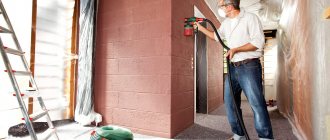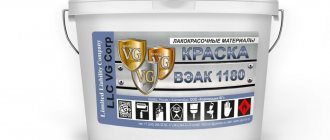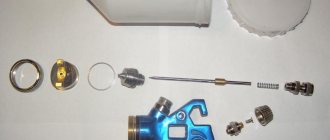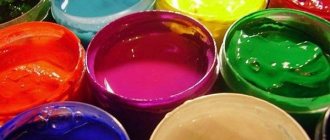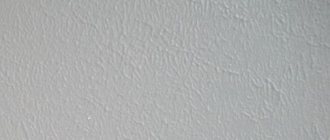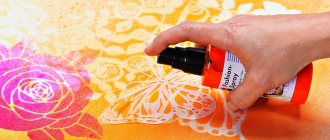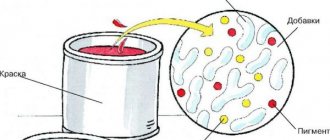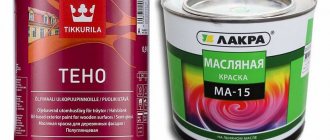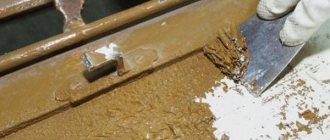Using a spray gun to apply water-based paint
Modern paints have good performance properties and many advantages. Is it possible to save water-based composition when painting the ceiling or walls with your own hands? This largely depends on the existing conditions in the room; the flow rate is affected by humidity and air temperature. Diluted water-based paint is used for painting metal, concrete, wood, brick and plastered surfaces.
Water-based compositions are an adhesive and viscous liquid, which is made from environmentally friendly materials that are safe for humans. How durable the water-based coating will be depends on the application method and the tool used during painting. To apply water-based paint, you can use one of the varieties of sprayer. Many people ask how to choose a spray gun for water-based paint? The first thing you need to do is familiarize yourself with the technical characteristics of these devices.
A sprayer is a very convenient device for painting; you can either make it yourself or purchase it in a store. Today, specialized stores sell different types of paint spray guns that can be used in industrial and domestic conditions. Thanks to spraying, the paint is applied in an even and neat layer to any surface.
To paint the ceiling, it is better to use not a roller, but a spray gun, which allows you to significantly save paint and varnish material and apply water-based paint in an equal, uniform layer. After the dye is applied, the water evaporates very quickly from the surface; after a few hours, a polymer film remains on the ceiling or walls, which will have good resistance to mechanical loads if the paint spray gun was chosen and used properly.
Thanks to the application of paint by spraying, the service life of the coating will be long, approximately 10-15 years. Before you start painting with this tool, you need to familiarize yourself in detail with the technology for painting ceilings or walls.
Technique for applying paint to the wall
Painting walls with an electric spray gun using water-based paint is carried out from top to bottom. First you need to go through the surface under the ceiling, gradually moving down. The distance from the tool to the wall should be at least 30 cm. Trying to maintain the set pace, walk the entire wall in one direction and let the layer dry. Apply the paint again (after the wall has dried), but in a perpendicular direction. You should not linger in one place so as not to get a thick stain in the middle of the wall.
Only after drying can you remove the masking tape - otherwise it is easy to damage the freshly painted layer. You must not forget about the instrument - it should be washed with water or solvent. The liquid is poured into the tank and driven through the sprayer.
Painting walls and ceilings with a spray gun saves a lot of time compared to traditional methods. You just need to do the preparatory work and mix the paint correctly. Out of habit, a spray gun may seem like a complicated tool, but after a few minutes of working with it, you will gain confidence. They can carry out high-quality painting of walls with any paint, even without the skills of a painter.
Types of spray guns
Different types of paint sprayers have different characteristics and design features. To use any model of the device, the pre-coloring mixture must be diluted with water to make it more liquid. Today, three types of this equipment are manufactured:
- hand spray gun;
- electric;
- pneumatic spray gun.
Manual models have a special suction hose, pump and filter. Thanks to the pump, the paint is sucked into the tank. Under pressure, the composition is fed into the nozzle and sprayed over the surface.
A good model of a hand-held spray gun allows you to paint ceilings and walls at a speed of up to 200 square meters in 1 hour. The price of hand-held spray guns for water-based paint depends on the manufacturer, the quality of the material from which the device is made and the number of nozzles included in the kit.
Electric paint sprayers come in a variety of power ratings. They are best suited for painting with water-based paint. Electric models have different pressures, which ensure the supply of the color mixture due to oscillations of the diaphragm. It is driven by a special connecting rod mechanism. Any electric device is more expensive than a manual spray gun, but electric sprayers are not suitable for applying every type of paint.
Important! Do not rush to dilute the coloring composition; it is important to take into account its viscosity. You only need to add water if the paint is too thick.
The pneumatic spray gun has very high productivity; it can be used to paint up to 400 square meters per hour. A pneumatic spray gun applies the mixture using compressed air supplied from a compressor. Compressed air is mixed with the painting solution in a special container, and this mixture is supplied through the spray nozzle to the surface of the ceiling or wall.
Types of spray guns
A sprayer for a water-based composition is characterized by speed and quality of coating, and a reduction in liquid consumption.
Based on the principle of operation, they are distinguished:
- mechanical;
- pneumatic (air);
- airless (electric, mains, battery) types of spray guns.
The operating principle of models with airless spraying is based on pushing the paint composition out of the nozzle under the pressure of a piston pump. By design, a hand tool is a block consisting of a pump and a reservoir.
Floor structures, which are characterized by performance and a range of adjustments, are used by professionals. The equipment consists of a block in which a motor, pump, reservoir, and gun are located. The parts are connected to each other by a hose.
Mechanical hand sprayer
For routine repairs, an economical option would be to use a piston-type design. A hand-held spray gun for water-based paint consists of a pump to which 2 hoses are connected. One is lowered into a tank with paint material, and the second is connected to the gun. Through the opening of the outlet valve, the composition enters the tube and is sprayed through the nozzle.
The working length of the nozzle is 4 m. The productivity of the spray gun is 250 sq. m. m/hour. To operate the device, you need an assistant to pump air with a hand pump every 3-5 minutes. When applying the finishing finish, roughness is allowed.
Pneumatic tool
The painting unit works in tandem with a pressure blower. The compressed air that enters the pneumatic spray gun for water-based paint breaks and pushes out the particles of the mixture, forming a torch. The sprayer treats the surfaces of parts, large areas.
Depending on the type of spraying, equipment with HVLP, HP, LVLP technologies is distinguished. When applying water-based paint, the composition is diluted. This is due to the drying of the material by air pressure supplied from the compressor.
The paint reservoir is located at the bottom or at the top, and the high-pressure hose is attached to the gun handle. Professional models are characterized by mobility. Operational safety is achieved through high-quality connection of parts.
Electric spray gun
The operation of the tool is carried out by a built-in piston pump and power unit. The power is designed to apply low viscosity liquid. High-quality coating is achieved using a material that is applied in thin layers. The device, powered by 220 V mains power, processes 240-250 sq. m/hour.
The electric spray gun for water-based paint is equipped with a portable compressor. The model differs from the manual version in its high cost. The price of budget units that are used for spraying water-based acrylic paint starts from 2 thousand rubles.
Airless devices, on which a fishing rod and a gun are mounted in a vertical direction, cost from 20 thousand rubles. Manufacturers produce battery-powered versions of sprayers and units with a built-in compressor.
Choosing a hand-held spray gun
A hand-held device can be purchased if you need to paint a small room; it is not necessary to buy an expensive pneumatic spray gun. For painting small areas, a manual model is perfect, with which you can apply water-based paint to walls or ceilings, the main thing is to make the composition of a suitable viscosity.
Hand sprayers last a long time, and if any part wears out or breaks, you can easily purchase a new part. The inexpensive, simplest model costs less than 1,000 rubles, while a professional hand-held device can cost 4,000 rubles or more. For example, manual paint sprayers from the Russian company ULIG allow you to paint surfaces with water-based and other mixtures with a density of 1.3 g/cm³.
It is advisable to purchase a sprayer with a metal body, so that mechanical impact or falls will not lead to damage to the device. When choosing a spray gun, it is advisable to purchase a model with a long hose, which ensures free movement of the spray gun. Manual models KRDP-3 and KRDP-4 are very similar in their characteristics to ULIG; they are used for water-based dyes, the viscosity of which is 20 din.
Hand sprayers make it easy and quick to paint large ceilings and walls. If it is necessary to paint at a height of more than 3 meters, there is no need to mount scaffolding; approximately 150 square meters can be painted in one hour.
Before you start using any manual paint sprayer, you must lubricate the cuffs and cylinder with machine oil. After lubrication, it is advisable to test the device with plain water, which will make it possible to determine the leak. During operation there is no need to press the trigger all the time. You can easily regulate the flow of the color mixture using a ball valve.
Electric models
Electric models of sprayers are produced by many companies, here is a list of the most popular and high-quality devices:
- Bosch;
- Wagner;
- Elmos;
- Black&Decker;
- Paint Zoom.
To apply water-based paint, you need to focus not only on the model of the sprayer, but it is also important to take into account the size of the nozzle and choose the right nozzle. Water-based compositions are sometimes sold very thick, so before applying the mixture, it must be properly diluted in accordance with the instructions.
An important role is played by the pressure indicator when spraying paint. If the nozzle hole is too small or the pressure is weak, then particles of the paint mixture will get stuck in the hose and other parts of the spray gun, which will prevent you from painting with a thin and even layer. Devices that supply the composition under high pressure are quite expensive; the dependence of cost on pressure is one of the main disadvantages of electric sprayers.
Reliable electrical devices from trusted companies cost at least 6,000 rubles, and not every equipment can correctly apply a thick water-based composition. Typically, manufacturers of electric paint sprayers that operate on 220 volts initially configure the equipment to operate at maximum efficiency.
Electric models can be divided into two categories, depending on the method of applying water-based paint:
- airless;
- sprayers operating at low pressure.
The airless method is used much more often. For example, the Fiolent KR1-260 sprayer, powered by electric current, sprays paint using the airless method. This device can operate at air temperatures of +1...+40 degrees. This equipment works with both liquid dye and thick compositions with a viscosity index of no more than 80 din.
The maximum productivity of the Fiolent KR1-260 sprayer is 260 ml/min. This device has a power of 60 W, which is enough to quickly paint a medium-sized room. The spray gun has an ergonomic handle, thanks to which the device is securely fixed in the hand.
Another popular and reliable household paint sprayer is the Bosch PFS 2000, its power is 440 W. It is suitable not only for painting with water-based compositions, but also for applying oil-based impregnations and varnishes. This sprayer is excellent at applying paint compounds to metal, wood and other surfaces. You can fine-tune the paint jet to avoid paint runs, splashes and stains.
Which spray gun is better for applying water-based emulsion?
Painting using devices involves spraying at low pressure and using an airless method. For the electric tool “Fiolent KR1-260”, which works with liquid and thick paint compositions, an airless method is provided.
The unit is operated at a temperature of +1…+40ºC. The power of the device is 60 W, productivity is 260 ml/min. The ergonomic handle securely fixes the gun in the hands of the master.
Electric spray gun “Caliber MASTER EKRP-350/2.6 M” is designed for applying a thick layer. The handle is molded from plastic. There is a hook at the top for hanging; a transparent plastic tank allows you to visually control the material consumption. Device power – 350 W, productivity – 280 ml/min.
The Bosch PFS 2000 spray gun is equipped with a side feed regulator and a switch with a scale. The device is connected by a durable air tube to the base compact unit. The shoulder straps are secured with carabiners. The motor start button is located at the top of the handle.
The ergonomic handle with rubber pads is comfortable for the operator. The power of the device is 440 W, productivity is 200 ml/min. The reservoir is designed to fill 800 ml of the mixture.
The Elitech KE 650 P model is designed for all types of water-based paint. The set contains 2 nozzles with a diameter of 1.8 and 2.6 mm. The spray gun consists of 2 parts connected by a corrugated hose. A handle is provided for transportation.
Using pneumatic models, the problem of painting large areas is solved. Lightweight spray gun Intertool PT-0140 is the best option for using water-based paint. Material is blown freely through a nozzle with a diameter of 1.8 mm. The tool is cast from aluminum, resistant to mechanical damage, and the paint is easy to clean.
The Sigma HP spray gun is the best option for a water-based composition. The tool has an affordable price of 400 rubles. A nozzle with a diameter of 2 mm is suitable for uniform spraying of thick formulations.
Features of choosing a tool for the ceiling
Most spray guns have a universal purpose. To choose a spray gun for painting the ceiling, it is recommended to look at electric tools. Not all units are designed for water-based composition.
For high ceilings, choose a tool equipped with a long hose. The use of an electric sprayer capable of pumping up a pressure of 2 atmospheres reduces the likelihood of coating defects and the formation of droplets.
When choosing a compression element for painting walls and ceilings, pay attention to the pressure, power and performance of the model, and the material of construction. The main role in the instrument is played by the body material and the nozzle.
Pneumatic spray guns
Pneumatic models are considered the most effective, compared to other equipment for painting with both water-based and other paint mixtures. A professional pneumatic model makes it possible to paint the surface of walls or ceilings covering an area of approximately 400 square meters in 1 hour. Pneumatic equipment is more expensive than manual and electric equipment.
Pneumatic-type units apply the coloring composition thanks to a compressor that compresses the air to high pressure, and then this air is mixed with the dye. These units allow you to adjust the power with which the liquid solution is sprayed onto the surface. Every beginner or professional painter can customize the air spray.
Before you start painting, it is recommended to test the unit using plain water. Only after test spraying can the coloring composition be prepared. The water-based solution is initially diluted with water, mixed thoroughly, and then applied to the surface.
Paint sprayers operating at low pressure - HVLP - allow you to process large volumes with low pressure of the applied mixture. Such equipment allows you to process walls or ceilings with any type of paint and varnish products.
With pneumatic sprayers, the air cap operates at a higher pressure than the inlet to the gun. The device has such design features that it performs economical painting of surfaces with a low degree of fogging.
Reduced pressure equipment can operate with any type of paint and varnish material. Such sprayers treat the surface by creating a wide spray, supplying dye in large volumes. If the paint is properly diluted with water, there will be no drips or any defects. Pneumatic devices consume large volumes of air; in one minute, from 200 to 430 liters of air are consumed, due to which the painting time is significantly reduced. The result is a very thin coating of sprayed paint and varnish material; this coating can be classified as extra-class.
How to choose the right device
Many, seeing a wide variety of sprayers, wonder how to choose a suitable model so that it is of high quality, lasts a long time and applies the color mixture well? First of all, it is important to pay attention to what material the device body is made of.
The best option is an aluminum device that has a nickel coating that prevents corrosion. Plastic equipment is short-lived and has a minimal service life, although it is lightweight. The holes on the lid should be brass, aluminum or stainless steel.
When choosing a device, you should also pay attention to the sealing gaskets. The best option is Teflon gaskets; they will last a long time. Other materials can be damaged and corroded by organic solvents contained in paint and varnish products.
You also need to pay attention to the barrel for the coloring composition. This container can be located below or above. Tanks are made of nylon and metal. Metal containers are easier to clean, while nylon ones are translucent, making it possible to determine how much mixture is left inside the tank.
If the spray gun will be used for painting a small volume, then you can purchase an inexpensive model for 400-1000 rubles, but if you plan to use the spray gun frequently, for painting large areas, it is better to buy a high-quality, professional model.
